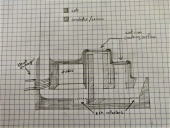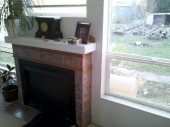Hey, thanks for the answer =)
Yes, you are right, I'm looking into an integrated central heating system, that would combine thermal solar, Rocket mass heater with a heat exchanger coil, and a cheap electric backup heater for when I'm on holidays for example, to prevent freezing.
My initial thought was indeed to have this system working for hot water heating through radiators, and sanitary hot water (boiler) for showers, kitchen tap etc.
Here is the diagram of my system, as I thought of initially:

So the hot water loop is first pushed by the pump into the 3-way valve, which depending on the needs will redirect the flow to the boiler, the radiators or both. the water cools off (as it warms the sanitary water or the radiators) before going to the RMH, the solar panels and the electric heater to heat up, then back again to the pump for another loop. Bypass loops allows me to cut parts of the circuit (for example to drain and prevent water to go in the solar panels in winter when it might freeze, or to prevent hot water from the solar panels from heating the RMH's mass on hot summer days). I didn't show this idea with anyone yet, so I hope it's not ridiculous, but it seems feasible to me, and I hope it would greatly reduce my electrical bill...
Now my question is mainly regarding that air-to-air heat exchanger in that video, and whether it wouldn't be smarter (in terms of energy efficiency) to directly heat up the air in the rooms with the RMH through a ventilation system, instead of heating water to be sent to the radiators. Obviously the limitation of this system would be that I can't really heat up the sanitary hot water with a air-to-air system, but for the space heating, I wonder which would be the best..?









